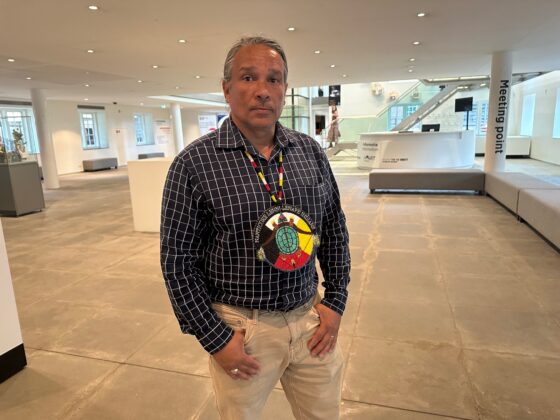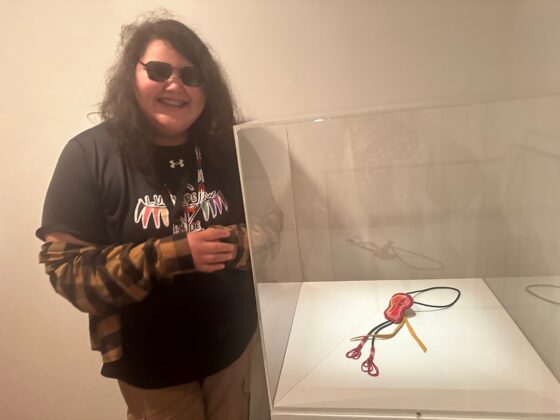Manahahtáanung or New Amsterdam? Tackling 400 years of history
Lauren Comiteau
While for many, 400 years of connection between Old Amsterdam and New is a celebratory anniversary, for “Manhattan’s” indigenous Lenape people, it’s the perfect time to set the record straight. Lauren Comiteau visited Amsterdam Museum for a new exhibition that explores this little known part of Dutch colonial history.
According to legend—and a letter sent by Peter Schagen back to his sponsoring Dutch West India Company—the indigenous Lenape tribes of what is now the east coast of the US and Canada sold Manhattan to Dutch merchant colonialists in 1626 for 60 guilders, or 24 US dollars.
“We say that’s a myth, because our leadership would not have entered into any type of agreement without something like this,” says Delaware Nation member Brent Stonefish, co-founder of the Éenda-Lǔnaapeewáhkiing Collective, pointing to a replica of a wampum belt, which are used to record treaties and agreements between people.
“And there are no records and there are no pictures of any type of wampum belt created. Also, we didn’t have a concept of ownership. We had a concept of sharing the land and having a relationship with it, the animals and the plants and living in harmony with them.” If anything, he says, a wampum belt would have meant sharing the land, not selling it. But for the document-loving Dutch, a sale is a sale.
“And that,” he says, “was the difference between our understanding of land ownership.”
Stonefish was speaking on the eve of the opening of a new exhibition, Manahahtáanung or New Amsterdam?, The Indigenous story behind New York, on display at the Amsterdam Museum through November 10, 2024, that seeks to bust some of those myths and put forward an indigenous-centred narrative of the decades-long period of Dutch colonization and its consequences for the land’s original inhabitants.
“We’re collaborators, not an afterthought, like we normally are,” says Brent Stonefish of the Lenape’s partnership with both the Amsterdam Museum and the Museum of the City of New York in creating Manahahtáanung or New Amsterdam?
“This exhibition turns traditional exhibitions on their heads,” adds George Stonefish, another Lenape who made the journey across the Atlantic to the banks of the Amstel. “It’s not an exhibition about stolen artifacts, but about what we’re sharing from ourselves.”
New collaboration
In a first, there were ritual ceremonies and spiritual cleansings involving burning sage and prayers in the Amsterdam Museum’s viewing spaces.
Before the exhibition even opened Thursday, the Lenape representatives shared with Amsterdam Museum curators a specially created wampum belt as a symbol of a new collaboration that seeks to reclaim their history, identity and culture. That wampum belt is now part of the exhibition.
“Cooperation between the parties is a really sensitive matter,” says Amsterdam Museum curator Imara Limon on the exhibition that has been a few years in the making. “With such a fraught history of unchecked violence and ongoing consequences for the Lenape, it’s not surprising that the institutional partners must earn trust gradually. I respect the Lenape who are willing to share their knowledge and experiences with us, [although] the extensive decision-making process takes some getting used to.”
This time, when the Dutch landed in New York to meet with the Lenape and co-collaborators from the Museum of the City of New York to discuss the exhibition, we came, says Limon, “with good intentions.”
“We are still here”
But that hasn’t always been the case. The Dutch first set foot on modern-day New York 400 years ago with a mandate from the Dutch West India Company to establish the colony of New Netherlands at the mouth of the Hudson River, with New Amsterdam as its capital.
What ensued was decades of war and disease, with the Lenape losing their land, livelihood and culture. The exhibition seeks to document that, along with the continuing struggles of indigenous people to retain and reclaim their culture.
“Over 16,000 of our people were taken into slavery by the Dutch,” says Brent Stonefish. “We know from oral tradition that they were taken to Indonesia, Suriname, Brazil and Russia, but we’re looking for the colonial documents about this slavery, or human trafficking as we call it today.”
According to Chief Urie Ridgeway, leader of the Nanticoke Lenape Nation, 1,600 of his people were killed during the 400-year-long “very problematic history” with the Dutch, with thousands more forcibly removed from their land, separated from their tribes, murdered, tortured, killed and raped. “There are 20,000 Lenape people left, with 90 percent of the population dying because of colonization,” he says. “But we are still here.”
Apology and reparations
And they’re looking towards the future. “I came here today as a diplomat, the leader of my nation,” says Chief Ridgeway. “We want and will seek an apology from the Dutch government.”

This is the first public announcement about the Lenape intentions to seek an apology and reparations from the national government. Although for now they are only meeting with Amsterdam and consular officials, Chief Ridgeway says it’s a start.
“We need stepping stones,” he says. “We are looking to have negotiations, to sit down and talk with the government here. There are also the Swedes, Great Britain, France, and the United States. We as a people entered into treaties and negotiations with each one of those countries at some period, which have been forgotten ever since. But that doesn’t mean those treaties don’t exist. We’re here to remind them we made promises to each other. And with the Dutch government having their 400-year celebrations, it seems like it’s the right opportunity to take these steps.”
Art and artifacts
All here agree that the exhibition is a good step forward. On the Dutch side, there are artifacts—including a replica of the Halve Maan, the ship on which Henry Hudson sailed into the bay that now bears his name, along with prints and documents—showing the European perspective. On the indigenous side, there is art documenting the arrival of the “people from salt water,” as colonists are called in the Lenape language, including beaded necklaces, a carved gourd and a decorated knife.
“Art for us is not just something on walls,” says Lenape Cory Ridgeway. “We wear it and live our lives in it.”
In one of two special commissions, Dutch artist Patricia Kaersenhout created the mixed media installation A Phantasmagorical Manhatta Island in collaboration with indigenous artist Leonard Harmon that opens the exhibition, using historical documents, texts and imagery to reimagine Lenape history.
“She combined all these texts and put them in AI, and then these images came up,” explains Limon. “Then she combined African textiles together with the images and glitter and a wampum belt. So it’s really an opening up of the imagination of this history that you actually don’t want to know, but which did happen, and what could have been otherwise.”
There are video presentations reflecting the oral tradition of the Lenape people. And indigenous artist Leonard D. Harmon created an installation of 366 prayers. “The prayers are not for me, because we never pray for ourselves, that would be selfish,” he explains. “I created these prayers for the people of the Netherlands, that we can continue the next 400 years in a better relationship than we did in the past 400.”
The next 400 years
Emma Stonefish, the 20-year-old daughter of Brent, proudly points to her brother’s bolo tie in the exhibition. On one side, it features missing and murdered indigenous women, while the other side commemorates the children found in unmarked graves from the residential schools where they were often sent.

As part of the younger generation who will be helping to create the Lenape-Dutch relationships of the future, she has no doubts what she wants. “My family has a philosophy of thinking seven generations ahead, so thinking about your grandchildren, your great grandchildren and your grandchildren after that,” she explains.
“So for me, I just want an environment where they know where they come from, where they know the history and that the truth can be told. Where they can retain their roots. I hunt and do ceremonies, and I practice the culture and language. But I hope one day my kids and my grandkids can actually speak full on.”
When Chief Urie Ridgeway was growing up in the US state of New Jersey in the 1970s, he couldn’t speak his own language. “Actually, when I grew up, it was against the law for me to even practice ceremonies. In 1978, we received our religious freedom in the US to conduct any ceremony we wanted without being persecuted,” he says.
“So I grew up having to fight and protest for anything that we wanted as Indian and Lenape people. But we shouldn’t have to protest to have religious freedom. We shouldn’t have to protest to have our identity. But going forward, we want positive relations, government to government. We can’t change the past, but we can find a good way to go forward.”
Thank you for donating to DutchNews.nl.
We could not provide the Dutch News service, and keep it free of charge, without the generous support of our readers. Your donations allow us to report on issues you tell us matter, and provide you with a summary of the most important Dutch news each day.
Make a donation